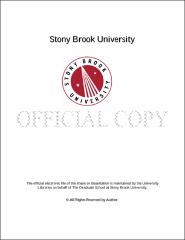| dc.identifier.uri | http://hdl.handle.net/11401/76256 | |
| dc.description.sponsorship | This work is sponsored by the Stony Brook University Graduate School in compliance with the requirements for completion of degree. | en_US |
| dc.format | Monograph | |
| dc.format.medium | Electronic Resource | en_US |
| dc.language.iso | en_US | |
| dc.publisher | The Graduate School, Stony Brook University: Stony Brook, NY. | |
| dc.type | Thesis | |
| dcterms.abstract | Nanocrystalline metals have useful mechanical properties such as high strength, improved wear resistance, and longer fatigue life; however, they are relatively unstable – grain boundary doping is a viable method towards stabilization [1-3]. After comparing the work of Murdoch and Schuh, that used a thermodynamic model to estimate grain boundary segregation enthalpy to the experimental work of Umbrajkar et al., it was realized that mechanical alloying is a processing route for grain boundary stabilization [10,11]. Whether or not chemical mixing has occurred is a good indicator of a powder system’s potential for grain boundary doping. 99Al1Si, 99Al1Mg, 99Al1Zr, and 99Al11Zn were mechanically alloyed with a Retch 100 Planetary Bal Mill. The samples were then analyzed with a Rigaku Ultima III X-ray Diffractometer to determine whether or not these powder systems have chemically mixed. It was found that the 99Al1Mg powder system chemically mixed during the 8Hr, 8mL run and during the 16Hr, 16.5mL run, and the 99Al1Zr powder system chemically mixed during the 4Hr, 16.5mL run. The enthalpy of segregation values for each binary powder system correlated to the chemical mixing shown in these results. | |
| dcterms.abstract | Nanocrystalline metals have useful mechanical properties such as high strength, improved wear resistance, and longer fatigue life; however, they are relatively unstable – grain boundary doping is a viable method towards stabilization [1-3]. After comparing the work of Murdoch and Schuh, that used a thermodynamic model to estimate grain boundary segregation enthalpy to the experimental work of Umbrajkar et al., it was realized that mechanical alloying is a processing route for grain boundary stabilization [10,11]. Whether or not chemical mixing has occurred is a good indicator of a powder system’s potential for grain boundary doping. 99Al1Si, 99Al1Mg, 99Al1Zr, and 99Al11Zn were mechanically alloyed with a Retch 100 Planetary Bal Mill. The samples were then analyzed with a Rigaku Ultima III X-ray Diffractometer to determine whether or not these powder systems have chemically mixed. It was found that the 99Al1Mg powder system chemically mixed during the 8Hr, 8mL run and during the 16Hr, 16.5mL run, and the 99Al1Zr powder system chemically mixed during the 4Hr, 16.5mL run. The enthalpy of segregation values for each binary powder system correlated to the chemical mixing shown in these results. | |
| dcterms.available | 2017-09-20T16:49:51Z | |
| dcterms.contributor | Trelewicz, Jason R | en_US |
| dcterms.contributor | Sampath, Sanjay. | en_US |
| dcterms.creator | Schwab, Lacey Lynn | |
| dcterms.dateAccepted | 2017-09-20T16:49:51Z | |
| dcterms.dateSubmitted | 2017-09-20T16:49:51Z | |
| dcterms.description | Department of Materials Science and Engineering | en_US |
| dcterms.extent | 97 pg. | en_US |
| dcterms.format | Application/PDF | en_US |
| dcterms.format | Monograph | |
| dcterms.identifier | http://hdl.handle.net/11401/76256 | |
| dcterms.issued | 2016-12-01 | |
| dcterms.language | en_US | |
| dcterms.provenance | Made available in DSpace on 2017-09-20T16:49:51Z (GMT). No. of bitstreams: 1
Schwab_grad.sunysb_0771M_12866.pdf: 4493813 bytes, checksum: 6d74cb10fdf40cefaa45d9549a90e969 (MD5)
Previous issue date: 1 | en |
| dcterms.publisher | The Graduate School, Stony Brook University: Stony Brook, NY. | |
| dcterms.subject | Aluminum alloys, Ball Milling, Binary alloys, Materials Science, Mechanical alloying, Planetary Ball Mill | |
| dcterms.subject | Materials Science -- Engineering | |
| dcterms.title | Synthesis of Binary Nanocrystalline Aluminum Alloys through High Energy Ball Milling | |
| dcterms.type | Thesis | |

